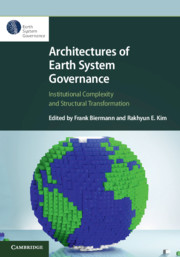Book contents
- Architectures of Earth System Governance
- Series page
- Architectures of Earth System Governance
- Copyright page
- Contents
- Contributors
- Acknowledgements
- 1 Architectures of Earth System Governance
- Part I The Building Blocks
- 2 Intergovernmental Institutions
- 3 International Bureaucracies
- 4 Transnational Institutions and Networks
- 5 Institutional Architectures for Areas beyond National Jurisdiction
- Part II Core Structural Features
- Part III Policy Responses
- Part IV Future Directions
- Glossary
- Index
- References
2 - Intergovernmental Institutions
from Part I - The Building Blocks
Published online by Cambridge University Press: 17 April 2020
- Architectures of Earth System Governance
- Series page
- Architectures of Earth System Governance
- Copyright page
- Contents
- Contributors
- Acknowledgements
- 1 Architectures of Earth System Governance
- Part I The Building Blocks
- 2 Intergovernmental Institutions
- 3 International Bureaucracies
- 4 Transnational Institutions and Networks
- 5 Institutional Architectures for Areas beyond National Jurisdiction
- Part II Core Structural Features
- Part III Policy Responses
- Part IV Future Directions
- Glossary
- Index
- References
Summary
What have scholars learned over the past decade about the forces that shape the creation, design, and adaptation of intergovernmental institutions in earth system governance and their influence on state behaviour? Context characteristics – shared, science-based knowledge; the behaviours involved; and the availability of alternative behaviours – can shape institutional creation, design and adaptation. The strategies states, existing institutions and non-state actors deploy, in turn, can promote institutional formation despite challenges or inhibit it despite propitious conditions. Context characteristics also can pose larger or smaller obstacles to institutional effectiveness. Institutions prove more effective when their designs reflect political, economic and social constraints as well as major actors’ power and incentives. They shape material, ideational and normative incentives and opportunities that channel states toward positive behaviours and away from negative ones. New research can build on recent findings by investigating complex interactions at and across the international, transnational, domestic and subnational levels of earth system governance.
- Type
- Chapter
- Information
- Architectures of Earth System GovernanceInstitutional Complexity and Structural Transformation, pp. 37 - 56Publisher: Cambridge University PressPrint publication year: 2020
References
- 1
- Cited by



